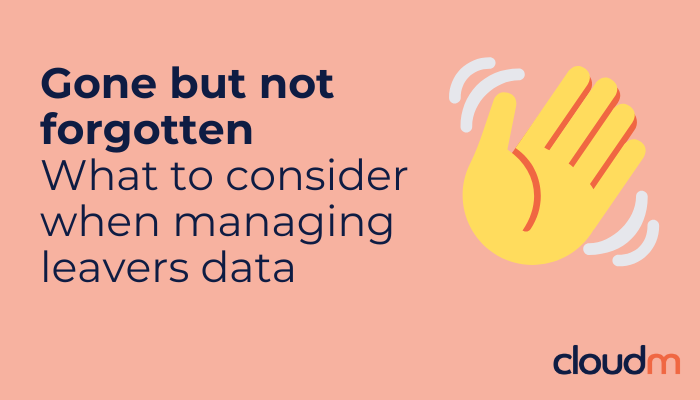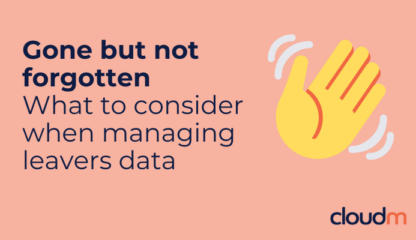Data is one of an organization’s most valuable assets. But if not managed correctly, it can also become a costly liability. With ever-evolving data protection laws and compliance requirements, businesses must find the right balance between retaining and deleting data. This is particularly crucial when managing data left behind by departing employees.
What is data archiving?
Data archiving is the process of storing data for long-term preservation so that it can be accessed when needed. Typically, data, such as emails and files, is archived when an employee leaves the company. The need to access archived data can arise due to reasons such as:
- Compliance requirements
- Legal requests
- Historical reference
Organizations therefore need to keep their data for a certain period. But while archiving data ensures long-term accessibility, it also introduces challenges, particularly when it comes to compliance and security. Organizations must carefully manage the fine line between retaining essential records and deleting outdated data.
Why is data archiving a balancing act?
Striking the right balance between data retention and deletion is a challenge for IT and compliance teams. While businesses need to keep data for audits and legal requirements, retaining it indefinitely leads to security risks and unnecessary costs. To complicate matters, collaboration platforms like Google and Microsoft don’t always align with business needs: Google, for example, permanently deletes most data after 30 days, which may not be enough for compliance purposes.
Keeping data forever is not the answer
Not retaining data for long enough creates problems. The same is true for the opposite end of the spectrum – keeping data indefinitely. “Forgotten data” not only accumulates storage costs, it also increases an organization’s security and compliance risk. For example, an organization found to be in breach of HIPAA faces penalties of up to $68,000 per violation per year as well as civil lawsuits and criminal charges. Therefore it is important that data can be purged upon request and after a defined period of time.
Beyond regulatory fines, excessive data storage also increases exposure to cyber threats. In 2023 alone, data breaches cost businesses an average of $4.45 million per incident. Holding onto unnecessary data creates more entry points for hackers and complicates compliance with laws like GDPR, which mandate data minimization.
Why should you archive your business data?
1. To comply with legal requirements
Ensuring that leavers’ data is stored securely and so that it can be searched and restored is not only best practice, it is also a regulatory requirement in many legislations.
Laws and directives such as GDPR, HIPAA, and NIS2 mandate that organizations retain certain types of data for predefined periods. Beyond retention, businesses must also ensure data is secure, accessible, and tamper-proof. Failing to meet these requirements can result in hefty fines, reputational damage and even legal action.
2. To preserve institutional knowledge
Employees come and go, but their digital footprint often holds valuable insights. It is important for the smooth running of your organization that emails and files are stored securely and can be accessed as needed, even after an employee has left the organisation.
3. To streamline legal and regulatory audits
Compliance doesn’t stop at retention. Organizations must also produce records quickly during audits or legal proceedings. Tools like CloudM Archive offer advanced search functionality which enables you to locate specific data sets without combing through mountains of information.
4. To ensure data security and integrity
With features like immutable storage and role-based access controls, archiving tools provide an added layer of security. This is critical for demonstrating that archived data has not been altered or tampered with—a requirement in many compliance scenarios.
5. To achieve cost efficiency
Storing inactive user data on primary platforms can be expensive. 3rd party tools can offer a cost-effective alternative, freeing up valuable resources whilst ensuring compliance needs are met.
How can CloudM Archive help secure your data and save costs?
With CloudM Archive, you can take control of your data: retaining it securely when needed and deleting it when it’s no longer required. Whether you need to reduce storage costs, ensure compliance, or quickly access archived records, CloudM Archive makes the process effortless and efficient.
CloudM Archive enables you to:
- Reduce costs: CloudM Archive can help companies reduce costs by automatically removing or reassigning user licenses.
- Automate retention policies: CloudM Archive can help companies automate retention policies based on selected organisational units (OUs) or create bespoke retention policies based on specific requirements.
- Remain in control of your data: CloudM Archive can help companies host leavers’ archived data in their own storage, avoiding vendor lock-in.
Simplify compliance with CloudM Archive
Achieving compliance doesn’t have to be a daunting task. With CloudM Archive, organisations can strike the perfect balance between data retention, accessibility and cost-efficiency. Whether you’re preparing for an audit, navigating complex regulations or simply safeguarding your institutional knowledge, CloudM Archive ensures your data is “gone but not forgotten” while enabling you to delete it as and when required.
Book a call with our Archive specialists today












